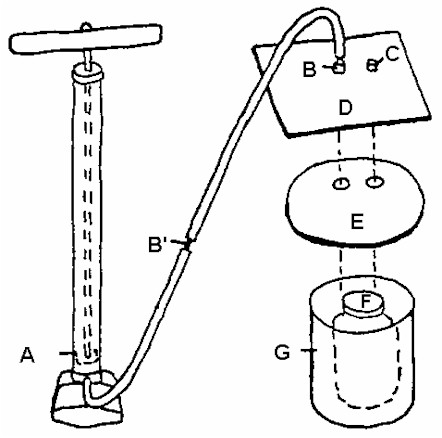|
This invention was declared in the public
domain on November 29, 1989, a gift to humanity,
by Allen Dong and Roger Edberg
I-Tech -
P.O. Box 413, Veneta OR 97487
A hand operated vacuum
packing system (Figure 1) was developed to facilitate the storage of dry
seeds. The system provides a means to seal containers with reduced oxygen
content. A sealed container prevents rehydration of seeds, thus extends
their viability. The reduced oxygen content suffocates adult insects that
are stored with the seeds, and also extends the viability of the seeds by
slowing down the seed respiration rate. This system can be used to vacuum
pack dry food. Moist food, however, needs to be properly sterilized before
it is vacuum packed.
Materials:
-
A bicycle tire pump, with
the pump plunger seal or cup in reverse (A), and used as a vacuum pump.
-
A tire inner tube stem
valve (B) is used as a check valve to prevent back flow of air into the
vacuum chamber.
-
A lid for the vacuum
chamber. The lid is made from a rubber stopper (C), a thin sheet metal
or plywood (D), and a sheet of rubber made from a tire inner tube (E).
The sheet of rubber (E) should be slightly larger than the lid (D) and
serves as a lid gasket.
-
A glass jar (F) with
resealable lid is used as vacuum-sealed container.
-
A large food can (G) is
used as a vacuum chamber. The can should be wider and taller than the
largest glass jar (F).

Figure 1. The vacuum packing system for
seed storage.
Construction:
1. Disassemble the bicycle
pump and reverse the leather or rubber cup on the end of the plunger rod
(A).
2. Remove the check valve in
the bicycle pump because it checks the airflow in the opposite direction.
This check valve is located at or near either end of the hose. In some
cases, the check valve can be disengaged by removing the valve, inverting
it and reinserting the valve in the pump for storage.
3. Attach a "Presta" type
bicycle inner tube stem valve (B) on the lid (D) or attach a "Schrader"
type check valve (B') in-line with the hose that connects the modified
bicycle pump to the lid (D). The "Schrader" valve core has spring tension.
For ease of pumping, disable the spring tension by cutting and removing
the spring. The "Presta" valve core does not have spring tension. The body
of the "Presta" valve is threaded, which provides for ease of attachment
on the lid (D). Both "Presta" and "Schrader" check valves must be attached
in the proper direction to allow air to be evacuated from the vacuum
chamber (G).
4. Drill or cut 2 holes in
the lid (D) and rubber gasket (E). One hole is for the "Presta" valve or
for a hose nipple when using an in-line "Schrader" valve. The other hole
is for a rubber stopper (C). The lid should be thin and slightly flexible
to facilitate the sealing of the uneven surface of the food can (G) with
the gasket (E). A gasket (E) made from tire inner tube may have ridges,
which provide air passageways and vacuum leakage. These ridges must be
filed or sanded down flat.
5. Options
-
a. When using tall
food jars (F), construct a taller vacuum chamber (G) by soldering 2
cans together.
-
b. A tall cooking
pot can be used as the vacuum chamber (G).
-
c. A pressure
cooker can serve as the lid (D), gasket (E) and vacuum chamber (G).
Operation:
Place seeds in a jar with
resealable lid (F) for example, a spaghetti sauce jar with "safety lock"
or "pop up" button on the lid or canning jar with mason dome lids. Secure
the jar lid by twisting it on snugly but not too tight so air can escape
from the jar during evacuation. The jar is placed in the vacuum chamber
(G). Cover the vacuum chamber with the rubber gasket (E) and lid (D).
Cover the open hole with the rubber stopper (C). Attach the pump hose on
to the lid stem valve ("Presta" valve) or hose nipple (when using an
in-line "Schrader" valve). Evacuate the chamber and then release the
vacuum rapidly by removing the rubber stopper (C). The rapid refilling of
air into the chamber will slam the jar lid down and seal the jar.
A 6 inch (16 cm) diameter x
6.5 inch (17 cm) vacuum chamber requires 8 to 20 strokes on the modified
bicycle pump 1.6 inch diameter x 24.4 inch (4 cm diameter x 62 cm) to
attain a suitable vacuum for sealing. Under these conditions, 15 to 25
inches of mercury (50 to 80 kilopascal) suction can be achieved. Larger
vacuum chamber requires more strokes.
|